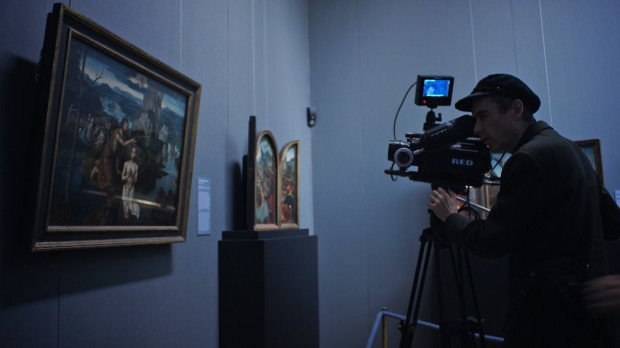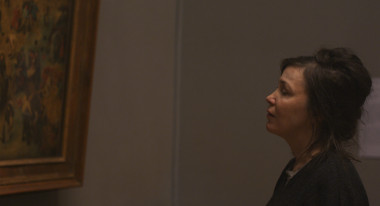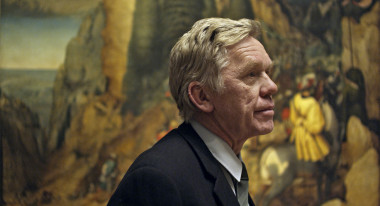 Back to selection
Back to selection
Jem Cohen on Museum Hours
 Jem Cohen shooting Museum Hours
Jem Cohen shooting Museum Hours Jem Cohen’s highly recommended Museum Hours — the winner of the Filmmaker-sponsored 2013 Cinema Eye Heterodox Award — opens in theaters today from Cinema Guild. Below is an excerpt (about half) of my interview with Cohen in the current print issue of Filmmaker. You can read the whole interview in the issue, and in the iPad version there’s also a 12-minute video with Cohen explicating various scenes in the film.
What does it mean, in 2013, to photograph — to reproduce — a painting? Does it, as Walter Benjamin wrote in his 1936 essay “The Work of Art in the Age of Mechanical Reproduction,” drain the painting of an essential “aura,” even as it makes the image itself accessible to a much larger audience? Does it, as John Berger elaborated in his 1972 book and television program, Ways of Seeing, alter the painting’s meaning, rendering the original a symbol of capitalist exchange? Or, in today’s image-sharing world of Tumblr, is reproduction nothing more than whimsical statement of affinity, of a “like?”
One of the many wonderful qualities of Jem Cohen’s latest feature, Museum Hours, is that it respectfully grapples with all of these theoretical thoughts, while also being, simply, a lovely meditation on friendship and the enduring value of culture. Set in and around Vienna’s grand old Kunsthistorisches Museum, Museum Hours introduces us to thoughtful, soft-spoken guard Johann (Bobby Sommer) — a former rock tour manager now content to spend his days gazing at the gallery’s spectacular collection as well as the spectrum of humanity that ambles through it. One such visitor is Anne, played by the Canadian singer-songwriter Mary Margaret O’Hara, brought to Vienna by the serious illness of a cousin, who lingers in a coma at a nearby hospital. Johann and Anne stare at paintings, share beers at a local cafe and observe everyday Viennese life. The film’s narrative trajectory is a gentle one. Cohen’s camera watches our couple, watches what they watch and often just ambles off on its own, capturing beautiful ephemera — shop signs streaked by rain, teen skateboarders cast in shadow under a dark overpass — with the same eye that it explores details in a Renaissance painting. Cohen’s democratization of imagery here isn’t polemical; instead he uses the lessons to be learned from a study of Brueghel to awaken our senses to the world surrounding us.
Recalling that sensation of experiencing one’s own city anew, as when you show it to a visiting friend, Museum Hours is all about, in its own way, ways of seeing. As such, it fits snugly within the sensuous archaeology of Cohen’s body of work, which often blends essay, documentary and fiction — sometimes, such as in Museum Hours, in the same film. The winner of the Filmmaker-sponsored Cinema Eye Heterodox Award, Museum Hours is released in June by Cinema Guild.
Filmmaker: It was interesting to watch your film twice in a short period of time, once on DVD and once on the screen. The second time, it felt a lot less narrative to me than it did the first time. The first time, I had all these questions that I expect you want an audience member to have. Who are these people? What’s going to happen to them? The second viewing felt much less like a narrative fiction film and much more like a documentary essay film. Without the weight of narrative expectation, I became aware of the story’s deliberate minimalism and how little we are told about the characters. The woman, for example. We really, as viewers, know very little about her.
Cohen: She ends up in Austria by chance, bad luck, and she’s a stranger there. You meet her randomly, just as the guard does, and you’re kind of like, “What is this creature?” So there’s a degree to which I wanted the viewer to share that enigma, that discovery. But also, I’m a believer here in not having to hand off too much about the characters because my real interest is in being with them in the moment, having that ring true — it’s not so much about filling in their back stories.
Filmmaker: I had many more questions about her on second viewing. She seems to travel to Vienna with a very small amount of money for a long trip. It’s her cousin, not a brother or sister, in the hospital, and their relationship is unclear. I wondered if she was perhaps using this illness as a way to flee some other situation in her life.
Cohen: I want people to kind of have to make their own movie — the first time you saw it, you made more of a narrative, the second time, you made something else; I like that. I want people to recognize something that feels authentic, but also to fill it in with people they know or experiences they’ve had. And regular people can, increasingly, find themselves on shaky ground, financially and otherwise, which still isn’t dealt with enough in movies. There’s that. But mostly, I like to peel narrative away just to the point where I think it’s still solid, but it’s pared down. I don’t like movies where I have no idea what’s going on or where characters just aren’t fleshed out enough. But more often there’s too much spoon-feeding. This is a movie about two people who are unmoored, and somehow, their navigation together makes certain things possible; there’s a quiet unfolding. You have to want to take that ride because they’re interesting to be with and unpredictable, not because you know their stories.
Filmmaker: How much did the actors themselves affect the way their characters appear onscreen?
Cohen: A great deal. I mean, I tend to build movies around real people and to be most interested in working with non-actors. Well, Mary Margaret O’Hara isn’t exactly a non-actor; in fact she’s an extraordinary one. She’s more known as a singer but she’s been in Robert Wilson’s The Black Rider and Robert Frank and Rudy Wurlitzer’s Candy Mountain, among other things. Her presence, both in performance and just as a person, made me want to put her in a movie — I’ve wanted to do that for more than 20 years! Once she was in, I shaped the character around her, and the same for Bobby, who plays Johann. When I first met him in Vienna, he was a driver and a waiter. I was doing a live music and film thing, Empires of Tin, which parallels the end of the Habsburg empire with the end of the Bush empire, using novels by Joseph Roth, and I needed a reader for the Roth texts. Paolo Calamita, who became my beloved producer on Museum Hours, suggested Bobby. He had a wonderful voice, but also immediately understood how to use it in a very un-dramatic way. When I heard that, I thought, “You know, I like restraint in a reading, but I really love it in an actor.” As I developed Museum Hours, I shot a test with him and the character became more and more central. With both leads I was quite happy to let them bring some of their actual lives into the part.

Filmmaker: Like what aspects?
Cohen: Bobby was never a museum guard or woodshop teacher, but he actually was a rock ‘n’ roll tour manager in the ’80s, along with many other odd jobs. So I encouraged him to spin some tales out of his own life into the film, but other scenes are tightly scripted. There’s enormous value in working with people who are not celebrities. The industry generally sees that as a terrible deficit, that you’re sacrificing “commercial potential,” but it would be very difficult to do what I wanted to do with famous actors.
Filmmaker: Their lives are too public.
Cohen: Their lives are too public, and it often becomes a distraction from the film because you’re either thinking about the actors revealing themselves or about how well they’re not revealing themselves. You’re thinking about it, you’re distracted. And the people who read film magazines are thinking, “Wow, they got so-and-so and that’s how the film was green lit.” They’re double distracted. It’s fascinating to me that Bresson never wanted to work with somebody twice.
Filmmaker: Because he didn’t want the carryover? He didn’t want the recognition of the person from film to film?
Cohen: Far be it from me to speak for Bresson. But I assume that’s correct, he didn’t want them carrying movie baggage. He wanted a certain kind of blank slate, where he could build something with them. Those were my reasons, too. I wanted us to build something together, then and there, that wasn’t a reflection of their past in the movies. And not because that’s a crime; it can be absolutely wonderful. I love to watch a Humphrey Bogart movie and see “Humphrey Bogart” in a role, and I have no problems when the Dardennes reuse actors. But, I get tired of people talking about how somebody is so great in a movie when what they’re really saying is, “Look how great so-and-so is faking it. Look at him go.” They’re watching the star as much as the character, with that awareness of the star plying their craft. And craft can be a fantastic thing. But without those distractions, you’re able to be with a character in what is to me more of a life moment than a cinema moment. It’s another realm.
Filmmaker: The other thing that struck me on second viewing was a certain chutzpah, if you will. I mean, the film is informed by two artistic visions, two ways of looking at the world: yours and Brueghel’s.
Cohen: Well, I’m no Brueghel and I don’t consider myself a “master,” but I did get excited recognizing in his work something I feel when I’m working. And that, to me, is the core of the whole project. Here I am, in this museum, looking at paintings from the 16th century and I’m getting this weird familiar feeling. I realized it had a lot to do with the experience of shooting on the street. That connection from Brueghel to documentary was a central spark. Part of it had to do with the fact that there are these large paintings in which there’s something going on everywhere, but there isn’t necessarily one focal point. You’re not being told where to look. And this is quite astonishing. It’s one of the many extraordinary things Brueghel seems to have stumbled upon. He’s one of the first to decouple landscape from religion. He’s one of the first to really care about the lives of peasants — with an unsentimental, fascinated, empathetic interest in how they actually live. That was very rare in his day and age. He looks at street life so carefully, noting all of these details without telling you what has to be dominant — letting the viewer create their own narratives. That is the stuff of a kind of filmmaking that fascinates me. It’s the stuff of somebody like Chris Marker, who cobbles together and riffs on all these fragments in a very personal way. It’s like a kind of “guided unguided tour.”

When I say “documentary” here I’m mostly referring to a street photography tradition that most of my work comes out of, which involves wandering on the street and not really having an agenda. I just like to roam and shoot with the guiding principle being to look and to listen. Don’t feel you have to pre-decide what you’re making; let the world itself tell you what you’re making. There doesn’t always have to be a template or a formula or even a script. Again, that’s not necessarily the endpoint with what I do, but it’s a great starting place.
Filmmaker: Of course, just wandering around, looking, often without an agenda, is exactly what one does in a museum.
Cohen: Exactly. I felt all of this while rambling about looking at the art and realized it was time to try and work some of this stuff into a movie — not just to make a movie utilizing documentary methods, but to actually discuss them, obliquely, within the film. And more and more as I worked on it, I realized, “Whoa, this is 25, 30 years of my thought process coming forth.” It was kind of an odd choice to have the conduit then be a narrative feature, instead of tilting more toward documentary essay, but then, the movie isn’t exclusively one or the other.
I’m not an academic and I don’t feel my goal is to be an “intellectual” filmmaker. And I don’t even think about making “art films” — certainly not in some classical European sense. A lot of what I come from and return to is very down to earth. Shooting on the street certainly is. A lot of my projects are ways to get at ideas but keep them grounded. So, Museum Hours allowed me to talk about why I’m a filmmaker and why art is important to me. But that’s not me comparing myself to Brueghel, you know? [Laughs]
